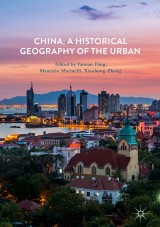Details

China: A Historical Geography of the Urban
|
106,99 € |
|
| Verlag: | Palgrave Macmillan |
| Format: | |
| Veröffentl.: | 20.11.2017 |
| ISBN/EAN: | 9783319640426 |
| Sprache: | englisch |
Dieses eBook enthält ein Wasserzeichen.
Beschreibungen
<div>This book offers a unique contribution to the burgeoning field of Chinese historical geography. Urban transformation in China constitutes both a domestic revolution and a world-historical event. Through the exploration of nine urban sites of momentous change, over an extended period of time, this book connects the past with the present, and provides much-needed literature on city growth and how they became complex laboratories of prosperity.</div><div><br></div><div>The first part of this book puts Chinese urban changes into historical perspective, and probes the relationship between nation and city, focusing on Shanghai, Beijing and Changchun. Part two deals with the relationship between history and modernity, concentrating on Tunxi, a traditional trade center of tea, New Villages in Shanghai and street names in Taipei and Shanghai. Part three showcases the complexities of urban regeneration vis-à-vis heritage preservation in cities such as Datong, Tianjin and Qingdao. <div><br></div><div>This book offers an innovative interdisciplinary and international perspective, which will be of interest to students and scholars of Chinese urban studies, as well Chinese politics and society.</div><div><br></div></div>
Chapter 1. Introduction; Yannan Ding.- PART I. Nation and City.- Chapter 2. Shanghai Parks in the Second Half of the Nineteenth Century – Architectural and Cultural Exchanges between the East and the West; Hsiu-Ling Kuo. Chapter 3. A City of Workers, a City for Workers? Remaking Beijing Urban Space in the Early PRC; Fabio Lanza.- Chapter 4. Changchun across 1949: Rebuilding a Colonial Capital City under Socialism in the Early 1950s; Yishi Liu.- PART II. Mediating History and Modernity.- Chapter 5. Tunxi: Urban Sectoral Agglomeration in a Regional Center of Tea Trade; Yi Zou, Xi Lin.- Chapter 6. What’s in a Name: The ‘New Village’ in Shanghai, 1930-1980; Duan Zheng, Xiaohong Zhang.- Chapter 7. The View of Comparison about Politics of Street Names between Taipei and Shanghai; Wenchuan Huang.- PART III. Contemporary City Building.- Chapter 8. Disneyfication or Self-referentiality: Recent Conservation Efforts and ModernPlanning History in Datong; Shulan Fu, Jean Hillier.- Chapter 9. The Politics of Aesthetics in Tianjin between Past and Present; Maurizio Marinelli.- Chapter 10. Living in the “Past”: The Effects of a Growing Preservation Discourse in Contemporary Urban China; Philipp Demgenski.<div><br></div>
<div><div>Yannan Ding is a Swire - Cathay Pacific visiting academic at St. Antony’s College, University of Oxford, UK. </div><div><br></div><div>Maurizio Marinelli is Associate Professor in East Asian History and Co-Director of the Asia Centre at the University of Sussex, UK. </div><div><br></div><div>Xiaohong Zhang is a professor and the head of the Institute of Chinese Historical Geography at Fudan University, China. </div><div><br></div></div>
This book offers a unique contribution to the burgeoning field of Chinese historical geography. Urban transformation in China constitutes both a domestic revolution and a world-historical event. Through the exploration of nine urban sites of momentous change, over an extended period of time, this book connects the past with the present, and provides much-needed literature on city growth and how they became complex laboratories of prosperity.<div>The first part of this book puts Chinese urban changes into historical perspective, and probes the relationship between nation and city, focusing on Shanghai, Beijing and Changchun. Part two deals with the relationship between history and modernity, concentrating on Tunxi, a traditional trade center of tea, New Villages in Shanghai and street names in Taipei and Shanghai. Part three showcases the complexities of urban regeneration vis-à-vis heritage preservation in cities such as Datong, Tianjin and Qingdao. This book offers an innovative interdisciplinary and international perspective, which will be of interest to students and scholars of Chinese urban studies, as well Chinese politics and society.</div>
Provides much-needed literature on how cities came about to exist before their reform-led development Offers an evolutionary perspective on how Chinese cities have formed and developed since the 19th century Will be of interest to students and scholars urban studies, human geography, sociology, anthropology and area studies
“This collection of fascinating essays on Chinese urban historical geography provides profound reflection on the meaning of the urban and the evolution of urbanism in China. The book fills the gap between urban studies and historical geography and reveals how urban transformations and contemporary city building are embedded in national development, politics and modernity, preservation and aesthetics in different historical periods.” (Fulong Wu, Bartlett Professor of Planning, University College London, UK) <p>“This fascinating collection of urban studies ranges across China’s urban geography over the past hundred years, exploring urbanism as it is manifested in a variety of ways. Some chapters take readers into intimate spaces of home and neighborhood; others explain the shape of the urban system over time; still others situate Chinese debates about urban planning and heritage within a global economy and transnational exchange of ideas. As a whole, the volume serves as an excellent introduction to the state of the field of urban Chinese historical geography and opens up new avenues for approaching Chinese and comparative urbanism.” (Kristin Stapleton, Professor of History, University at Buffalo, State University of New York)</p>
Diese Produkte könnten Sie auch interessieren:

Der Aufstand der Jugendlichen in den Banlieues: Eine Analyse der Pariser Unruhen von 2005

von: Ahmed El- Mamouni

23,00 €















